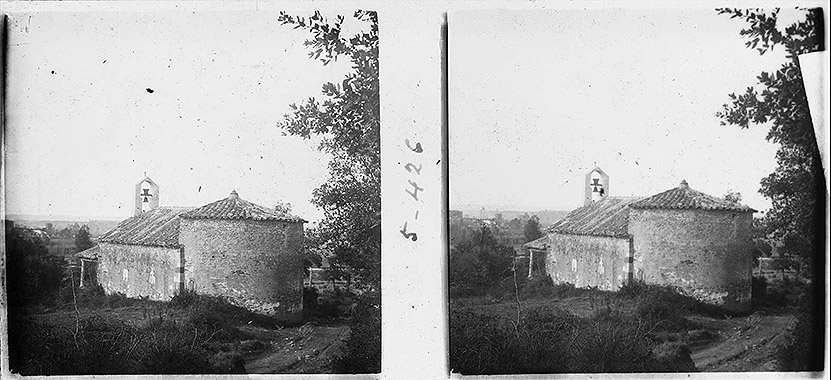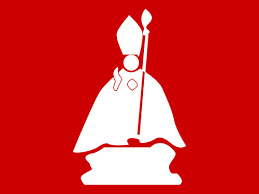Think
San Fermín and the friendship between Gerona and Navarre in the 17th century
Another gem from the Chair of Navarrese Heritage and Art: a brief account of the relics of the saint in the diaries of Father Pomeras, a Franciscan Franciscan.
about the relics of the saint in the diaries of Father Pomeras, a Franciscan from Gerona.
from Gerona. This story will undoubtedly please both historians and Hispanic philologists.
Hispanic philologists alike: the textual sources are not to be sniffed at.

Chapel of Sant Fermí in Flaçà, Josep Salvany i Blanch (1917)
Flaçà is a town in Girona, located in Gironès, in the south of Baix Empordà, close to the capital, next to the river Ter. It currently has just over a thousand inhabitants (1093 inhabitants in 2019). San Fermín is present in its toponymy and devotion, as there is a camí (path), a source and the Shrine of Our Lady of Fair Love called Sant Fermí. The small church was built in the second half of the 16th century, as evidenced by the date of 1579 on the lintel of entrance. It had a relic of San Fermín, donated by Pamplona and venerated for a century and a half, from 1678 until 1827, when it disappeared due to theft. This is its brief history.
In 1678, the Franciscan friar Fr. Pedro Pablo Pomeras, at that time vicar of the convent of Girona, had just returned from the Holy Land. At written request of the local hero Juan Batlle, he received, as he himself detailed in a written chronicle, the commission from the clergy and the town of Flaçà
"As it was to go to the city of Pamplona, Cabessa of the Kingdom of Navarre, a hundred leagues from here, to look for the relic of the glorious bishop and martyr San Fermin, son of the said city of Pamplona and of all the Kingdom of Navarre...".
On 14th September 1678, Fr. Pomeras received the papers and the dispatches as promissor, from the hands of the jurors, workers and priest President of Flaçà, as well as from the Bishop of Girona, D. Fray Alonso Balmaseda y Osorio, Augustinian, in the presence of the aforementioned D. Juan Batlle de Flaçà, benefactor who paid the expenses of the journey and acts of reception of the relic, in an amount of no less than one hundred doubloons.
Pomeras left Gerona on 14 September to arrive in Pamplona twelve days later, on the 26th. He recorded in writing his route pathway, the stops and the distances between them, which did not exceed ten leagues by workshop. It is worth noting that during the first stages he obtained letters of recommendation useful to his purpose: In Aulot (Olot) he obtained the favour of D. Francisco de Velasco, Master of the Field General in the Principality of Catalonia, brother of the Count of Fuensalida, D. Antonio de Velasco y Ayala, at the time Viceroy and Captain General of Navarre. And on the 15th, in Ripoll, he obtained the guarantees of the Pamplona-born Diego de Mirafuentes, Field Master of the Tercio de Toledo, and Pedro de Saravia y Mendoza, the latter the author of an important donation to the sacristy of Pamplona Cathedral in 1682, according to J. Goñi Gaztambide.
After passing through Berga, Agramunt, Balaguer, Barbastro, Huesca, Quel, Lumbier..., on the 26th of September, theday that the feast and office of the glorious bishop and martyr San Fermin (?) was celebrated in the city of Pomplona, Father Pomeras says of him and his companions that they entered Pamplona in the morning. The following day, the 27th, they went to present their dispatches and to pay their respects to the Viceroy. The 29th of September, the feast of St. Michael, was set as the date for the submission and reception of the relic. In the meantime, the City and the clergy filed an ecclesiastical lawsuit to which the Vicar General of the Diocese and the Cathedral Chapter responded with an order prohibiting the submission of any relic under penalty of major excommunication latae sententiae and a fine of two thousand gold florins to be applied to things belonging to the Church.
They were in confusion for fifteen days. In the meantime, with the favour of the Viceroy and the Bishop of Pamplona, the Franciscan D. Francisco Roig o Roche, absent due to pastoral visit , the matter was settled and it was agreed that the 15th October, the feast of Saint Teresa, would be the afternoon for the extraction of the relic, according to the following account by Fr Pomeras himself:
"We went there in the form of Siudad and attendance of all the clergy; and all in the parish church of St. Lorenço where the reliquaries of the glorious bishop and martyr Sant Fermin are placed. We entered the church, we closed the doors because of the tumult of the people, so as not to cause a riot or noise because the people did not want the relic of the glorious Saint to be removed. They had me dressed with all the vestments, even a pluvial cloak, lighting many torches; and then they made me take the saint down from the altar of his chapel, which is half a body. And placed on the high altar of the said San Lorenço, they opened that Holy Reliquary that opens at one corner of the said Holy Body, and it is with three keys: one is held by the Inlustre Siudad; the other by the workman of the Church of the said San Lorenso; the other by the priest of the Church. And while we were doing this, we were in great confusion because the report who had the one key was lost, as the reliquary had not been opened for eighty years. They opened and cleaned the reliquary because it was very dirty at the time.
"I myself took the holy relics out of their place and they were given to me in three parts, neither the largest nor the smallest (but the medium size); they were placed in a silver reliquary that the illustrious and noble city of Pamblona had ordered to be made, so that I could come with confidence, and they were given to me with great authority and devotion; and with the dispatches that were given to me, all together. This was from the Lord Vicar General, Dn. Antonio Olivarri (in reality, Ceferino de Ulibarri), and taking it from him he gave it to me to adore myself; and with all the servants on their knees, I gave it to everyone to adore; and in all this I thanked all those gentlemen on my behalf and on behalf of the noble town of Flaça and we left".

Miquel Vico, Shrine of Our Lady of Fair Love de Sant Fermí, Flaçà (2013), fragment: Wiki
Between 16 and 28 October 1678, the pious retinue travelled from Pamplona to Girona, passing through Lérida. Father Pomeras stopped for a few days at the Franciscan convent of Gerona. Juan Batlle was waiting there. The start of the festivities to receive the relic of San Fermín took place on Saturday afternoon, 10 December, with attendance of 24 priests, twelve Franciscan religious and 24 knights. In the village of Mollet (now Sant Joan de Mollet) a local procession joined the procession until it reached Flaçà, where, in the open air, there was a highly decorated ephemeral altar: here the relic was exhibited, the dispatches were read and the people of Mollet were united with those of the town,
"We went to the church of Flaçà under the pallium; the noble knights carried it with 24 torches, with many other lights and 24 rain capes, and I went under the pallium, as promissor with the holy relic, with a lot of music. And on entering the church, the Compline was sung with great majesty and solemnity. At the end of the Compline, the Holy Relic was adored by all the people. Relic was adored by all the people who were many from the whole region; at the end of the prayers, the bells of all the villages of the region and of the town were rung, giving thanks to God for such a great benefit, in giving them such a great Saint as their patron saint; in addition to this, with many shots, coetes and luminaries".
The festivities of Flaçà ended with a solemn mass and preaching on Sunday morning, the 11th, and a thanksgiving mass on Monday morning, the 12th.

Read the completearticle "Ritual and protocol in the fiesta of San Fermín".
on the website of the Chair de Patrimonio y Arte Navarro,
Cycle of San Fermín (D. José Luis Molins Mugueta)






